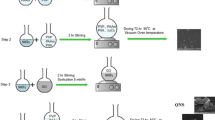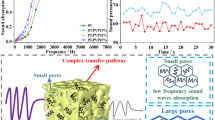Abstract
The innovative objective of present work is to evaluate the optical properties of the pure PVC and PVC composites with 5 wt.% organosilicon. The composite of PVC /organosilicon has been prepared by casting method. The optical properties of pure PVC and PVC/organosilicon thin films were measured in the wavelength range (250–1300 nm) by utilizing the diffusive reflectance device at room temperature 307 K. The optical properties as: absorption, reflectance, transmittance, refractive index, dielectric constant, optical conductivity, urbach energy and skin depth were calculated. The energy gap of direct transition was decreased from (4–2.2 eV), and for the indirect allowed also decreased from (3.4–1.8 eV), these values indicated the PVC thin films effected by the organosilicon. In details, the urbach energy have been decreased accompanied declines the energy gap after PVC mixing with organosilicon. The dispersing energy and the effective single oscillator were increased. The high frequency of dielectric constant and effective mass were increased of thin films of PVC modified with organosilicon. XRD and SEM were employed upon the sample to demonstrate the semi-crystalline and porous structure. The modified thin films of PVC with organosilicon have many applications as optical stability in electronic applications, low fabrication cost, non-flammability, high heat borne, coating the inner lining of the rocket engine, and heat shielding material.
Similar content being viewed by others
Data Availability
The data that support the findings of this study are available from the corresponding author, [initials]. The data are not publicly available due to containing information that could compromise the privacy of research participants.
References
Ahmed AA (2014) Synthesis, Characterization and Optical Properties of New Pvc- Amines Polymers. J Al-Nahrain Univ 17:7–13
El Sayed AM, Morsi WM (2013) Dielectric relaxation and optical properties of polyvinyl chloride/Lead monoxide nanocomposites. Wiley 34:2031–2039
Hussein MA, Alam MM, Asiri AM, Al-amshany ZM, Hajeeassa KS, Rahman MM (2019) Ultrasonic-assisted fabrication of polyvinyl chloride/mixed graphene-carbon nanotube nanocomposites as a selective ag+ ionic sensor. J Compos Mater 53:2271–2284
Al-Taa’y W, Nabi MA, Yusop RM, Yousif E, Abdullah BM, Salimon J, Salih N, Zubairi SI (2014) Effect of Nano ZnO on the Optical Properties of Poly(vinyl chloride) Films. Int J Poly Sci 2014:697809 (2014) 1–6
Abed RN, Mohammed K, Ahmed DS, Hadawey A, Yousif E (2021) Enhancing optical properties of modified PVC and Cr2O3 nanocomposite. Trans Electr Electron Mater 22:317–327
Ebnalwaled AA, Thabet A (2016) Controlling the optical constants of PVC nanocomposite films for optoelectronic applications. Synth Met 220:374–383
Abdullah ET, Hasan SM, Naje AN (2013) Optical properties of PVC-MWCNT nano composites. Indian J Pure Appl Physics 51:77–80
Yousif E, Al-Taa’y A, Noaman R, Esmael B, Abdalameer J, Abbas Q, Ahmed A (2016) Effect of Nano TiO2 on the optical properties of PVC contains Triazole moieties. Yanbu J Eng Sci 12(1437H):21–27
Turhan Y, Dogan M, Alkan M (2010) Poly(vinyl chloride)/kaolinite nanocomposites: characterization and thermal and optical properties. Ind Eng Chem Res 49:1503–1513
Abdallh M, Hamood O, Yousif E (2013) Study the optical properties of poly (vinyl alcohol) doped cupper chloride. J Al-Nahrain Univ 16:17–20
Mohammed SA, Yusop RM, Abdulsattar M, Abed R, Ahmed DS, Ahmed AA, Ahmed AA, Ali B, Yousif E (2019) Additives Aid Switch to Protect the Photodegradation of Plastics in Outdoor Construction NJES 22: 277–282
Ahmed A (2015) Synthesis and modified of poly(vinyl chloride) contains Triazole moieties and studying the optical properties of new polymers. J Al-Nahrain Univ 18:66–73
Al-Daeif Y, Yousif E, Nabi MA (2012) Synthesis of New Polymers Derived from Poly (Vinyl Chloride) and Study Their Optical Properties. J Al-Nahrain Univ 15:79–83
Ameer AA, Abdallh MS, Ahmed AA, Yousif EA (2013) Synthesis and Characterization of Polyvinyl Chloride Chemically Modified by Amines Open. J Polymer Chem 3:11–15
Abdallh M, Bufaroosha M, Ahmed A, Ahmed DS, Yousif E (2020) Modification of poly(vinyl chloride) substrates via Schiff’s base for photochemical applications. J Vinyl Addit Technol 26:475–480
Yousif E, Abdallh M, Hashim H, Salih N, Salimon J, Abdullah BM, Win YF (2013) Optical properties of pure and modified poly(vinyl chloride). Int J Ind Chem 4:1–8
Yousif E, Abdallh M, Hashim H, Ahmed A, Ahmed DS, Yusop RM, Ahmed AA (2019) Enhancement of the photo-chemical properties and efficacy of the mixing technique in the preparation of Schiff base-cu(II)/poly(vinyl chloride) compounds. Emerg Mater res 2:505–512
Yousif E, Ahmed DS, Ahmed AA, Hameed AS, Muhamed SH, Yusop RM, Redwan A, Mohammed SA (2019) The effect of high UV radiation exposure environment on the novel PVC polymers. Environ Sci Pollut Res 26:9945–9954
Emad A, Hameed YAS, Bakir ET (2007) Synthesis and Photochemical Study of Poly(Vinyl Chloride)-1,3,4-Oxadiazole and 1,3,4-Thiadiazole. J Al-Nahrain Univ 10:7–12
Abdallh MS (2013) Synthesis and optical properties study of some metal complexes of poly(vinyl chloride)-Pyridine-4-Carbohydrazide. J Al-Nahrain Univ 16:24–29
Ahmed A, Najim T, Salimon J, Salih N, Graisa A, Farina Y, Yousif E (2010) Optical properties modification of poly(vinyl chloride) using complexes of 2-amino acetate Benzothiazole. ARPN 12:43–45
Abed RN, Yousif E, Abed ARN, Rashad AA, Hadawey A, Jawad AH (2021) Optical properties of PVC composite modified during light exposure to give high absorption enhancement. J Non-Crys Solids 570:120946. https://doi.org/10.1016/j.jnoncrysol.2021.120946
Zuo Y, Liang X, Yin J, Gou Z, Lin W (2021) Understanding the significant role of SiAOASi bonds: Organosilicon materials as powerful platforms for bioimaging. Coordination Chem Rev 447:214166. https://doi.org/10.1016/j.ccr.2021.214166
Francis A (2021) Biological evaluation of preceramic organosilicon polymers for various healthcare and biomedical engineering applications: a review. J Biomed Mater Res 109:744–764
Nicholson JW (2012) The chemistry of polymers, 3rd ed. RSC Publisher, Cambridge
Starnes Jr WH (2002) Structural and mechanistic aspects of the thermal degradation of poly(vinyl chloride). Prog Polym Sci 27:2133–2170
Mohamed SH, Hameed AS, El-Hiti GA, Ahmed DS, Kadhom M, Baashen MA, Bufaroosha M, Ahmed AA, Yousif E (2021) A process for the synthesis and use of highly aromatic Organosilanes as additives for poly(vinyl chloride) films. Processes 9:1–14
Mohamed SH, Hameed AS, El-Hiti GA, Yousif E, Alotaibi MH, Ahmed DS, El-Hiti GA (2021) New porous silicon-containing organic polymers: synthesis and carbon dioxide uptake. Processes 8:1–14
Bates S, Zografi G, Engers D, Morris K, Crowley K, Newman A (2006) Analysis of amorphous and nanocrystalline solids from their X-ray diffraction patterns. Pharm Res 23:2333–2349
Abed RN, Abed ARN, Yousif E (2021) Carbon surfaces doped with (Co3O4-Cr2O3) nanocomposite for high-temperature photo thermal solar energy conversion via spectrally selective surfaces. Prog Color Colorants Coat 14:301–315
Abed RN, Abdallh M, Rashad AA, Hadawey A, Yousif E (2021) New coating synthesis comprising CuO:NiO/C to obtain highly selective surface for enhancing solar energy absorption. J Polymer Bull 78:433–455
He G, Chen X, Sun Z (2013) Interface engineering and chemistry of Hf-based high-k dielectrics on III–V substrates. Surf Sci Rep 68:68–107
Abed RN, Abed ARN, Khamas FA, Abdallh M, Yousif E (2020) High performance thermal coating comprising (CuO:NiO) nanocomposite/C spectrally selective to absorb solar energy, Prog. Color, Colorants, Coat 13:275–284
Al-Taa'y WA, Ameer AA, Al-Dahhan WH, Abddallh M, Yousif E (2015) Optical constants of poly(vinyl chloride) doped by nano ZnO. J Chem Pharm Res 7:536–541
Phukan P, Saikia D (2013) Optical and structural investigation of CdSe quantum dots dispersed in PVA matrix and photovoltaic applications. Int J Photoenergy 2013:728280, 1–6. https://doi.org/10.1155/2013/728280
Mariappan R, Ponnuswamy V, Ragavender M (2012) Characterization of CdS1-xSex thin films by chemical bath deposition technique. Optik 123:1196–1200
Dolai S, Sarangi SN, Hussain S, Bhar R, Pal AK (2019) Magnetic properties of nanocrystalline nickel incorporated CuO thin films. J Magn Magn Mater 479:59–66
Hassanien AS, Akl AA (2015) Influence of composition on optical and dispersion parameters of thermally evaporated non-crystalline Cd50S50-xSex thin films J. Alloys Compd 648:280–290
Abdullah OG, Saber DR (2012) Optical absorption of poly-vinyl alcohol films doped with nickel chloride. Appl Mech Mater 110–116:177–182
Hassanien AS, Akl AA (2018) Optical characteristics of iron oxide thin films prepared by spray pyrolysis technique at different substrate temperatures. Appl Phys A 124:752–1–752–752–1–716
Yang A, Fan H, Xuexi Y, Chen J, Li Z (2008) Effects of depositing temperatures on structure and optical properties of TiO2 film deposited by ion beam assisted electron beam evaporation. Appl Surf Sci 254:2685–2689
Al-Bataineh QM, Alsaad AM, Ahmad AA, Al-Sawalmih A (2019) Structural, Electronic and Optical Characterization of ZnO Thin Film-Seeded Platforms for ZnO Nanostructures: Sol–Gel Method Versus Ab Initio Calculations. J Electron Mater 48:5028–5038
Stamate MD (2000) Dielectric properties of TiO2 thin films deposited by a DC magnetron sputtering system. Thin Solid Films 372:246–249
Souri D, Tahan ZE (2015) A new method for the determination of optical band gap and the nature of optical transitions in semiconductors. Int J Appl Phys B 119:273–279
Sharma P, Katyal SC (2007) Thickness dependence of optical parameters for Ge–se–Te thin films. Mater Lett 61:4516–4518
Sardar K, Dan M, Schwenzer B, Rao CNR (2005) A simple single-source precursor route to the nanostructures of AIN, GaN and InN. J Mater Chem 15:2175–2177
Fasasi A, Osagie E, Pelemo D, Obiajunwa E, Ajenifuja E, Ajao J, Osinkolu G, Makinde WO, Adeoye AE (2018) Effect of precursor solvents on the optical properties of copper oxide thin films deposited using spray pyrolysis for optoelectronic applications. Am J Mater Synth Process 3:12–22
Spitzer W, Fan H (1957) Determination of optical constants and carrier efective mass of semiconductors. Phys Rev 106:882–890
Alsaad AM, Al Bataineh QM, Ahmad AA, Albataineh Z, Telfah A (2020) Optical band gap and refractive index dispersion parameters of boron-doped ZnO thin films: a novel derived mathematical model from the experimental transmission spectra. Optik 211:164641
Kittel C (1986), Introduction to solid state physics, 6th edition., translated by Y. Uno, N. Tsuya, A. Morita and J. Yamashita (Maruzen, Tokyo, 1986) book, 124-129
Pankove JI (1975) Optical Processes in Semiconductors, book. Dover Publications Inc., New York, NY, USA, p 91
Mansour AF, Mansour SF, Abdo MA (2015) Improvement structural and optical properties of ZnO/PVA nanocomposites. IOSR J Appl Phys 7:60–69
Urbach F (1953) The long wavelength edge of photographic sensitivity and of the electronic absorption of solids. Phys Rev 92:1324
Hassanien AS, Akl AA (2016) Effect of Se addition on optical and electrical properties of chalcogenide CdSSe thin films. Superlattice Microst 89:153–169
Al-Azzawi ZM, Al-Baidhani M, Abed ARN, Abed RN (2021) Influence of Nano silicon carbide (SiC) embedded in poly(vinyl alcohol) (PVA) lattice on the optical properties. Silicon. https://doi.org/10.1007/s12633-021-01325-8
Alsaad AM, Ahmad AA, Qattan IA, Al-Bataineh QM, Albataineh Z (2020) Structural, optoelectrical, linear, and nonlinear optical characterizations of dip-synthesized undoped ZnO and group III elements (B, Al, Ga, and in)-doped ZnO thin films. Crystals 10:252
Ahmad A, Alsaad AM, Al-Bataineh QM, Al-Naafa MA (2018) Optical and structural investigations of dip-synthesized boron-doped ZnO-seeded platforms for ZnO nanostructures. Appl Phys A 124:458–1–458–458–1–413
Chauhan R, Srivastava AK, Tripathi A, Srivastava KK (2011) Linear and nonlinear optical changes in amorphous As2Se3 thin film upon UV exposure. Prog Nat Sci Mater Int 21:205–210
Zahran HY, Yahia IS, Alamri FH (2017) Nanostructured pyronin Y thin films as a new organic semiconductor: linear/nonlinear optics, band gap and dielectric properties. Physica B 513:95–102
Abed AN, Abed RN (2022) Characterization effect of copper oxide and cobalt oxide nanocomposite on poly(vinyl chloride) doping process for solar energy applications. Prog Color Colorants Coat 15:235–241
Spitzer W, Fan H (1957) Determination of optical constants and carrier effective mass of semiconductors. Phys Rev 106:882–890
Shen Q, Katayama K, Sawada T, Yamaguchi M, Toyoda T (2006) Optical absorption, photoelectrochemical, and ultrafast carrier dynamic investigations of TiO2 electrodes composed of nanotubes and nanowires sensitized with CdSe quantum dots. Jpn J Appl Phys 45:5569–5574
Shen Q, Katayama K, Sawada T, Toyoda T (2008) Characterization of electron transfer from CdSe quantum dots to nanostructured TiO2 electrode using a near-field heterodyne transient grating technique. Thin Solid Films 516:5927–5930
Timoumi A, Bouzouita H, Rezig B (2013) Characterization and Wemple DiDomenico model of indium sulphide thin layers for photovoltaic applications. Aust J Basic Appl Sci 7:448–456
Shaaker HS, Hussain WA, Badran HA (2012) Determination of the optical constants and optical limiting of doped malachite green thin films by the spray method. Adv Appl Sci Res 3:2940–2946
Taunk PB, Das R, Bisen DP, Tamrakar RK (2015) Structural characterization and photoluminescence properties of zinc oxide nano particles synthesized by chemical route method. J Radiat Res Appl Sci 8:433–438
Hassanien AS (2016) Studies on dielectric properties, opto-electrical parameters and electronic polarizability of thermally evaporated amorphous Cd50S50−xSex thin films. J Alloys Compd 671:566–578
Sharma N, Sharda S, Sharma V, Sharma P (2012) Optical analysis of Ge19Se81−xSbx thin films using single transmission spectrum. Mater Chem Phys 136:967–972
He G, Liu J, Chen H, Liu Y, Sun Z, Chen X, Liu M, Zhang L (2014) Interface control and modification of band alignment and electrical properties of HfTiO/GaAs gate stacks by nitrogen incorporation. J Mater Chem C2:5299–5308
Taha TA, Rammah YS (2016) Optical characterization of new borate glass doped with titanium oxide. J Mater Sci Mater Electron 27:1384–1390
Badran H A, Al-Mudhafer M F, Hassan Q M, Al-Ahmad A Y (2012) Study of the linear optical properties and surface energy loss of 5’,5”-dibromo-o-cresolsulfophthalein thin films. Chalcogenide Lett 9: 483–493
Taha TA, Ismail Z, Elhawary MM (2018) Structural, optical and thermal characterization of PVC/SnO2 nanocomposites. Appl Phys A Mater Sci Process 124:307–339
Rajesh K, Crasta V, Kumar NBR, Shetty G, Rekha PD (2019) Structural, optical, mechanical and dielectric properties of titanium dioxide doped PVA/PVP nanocomposite. J Poly Res 26:99–1–99–99–1–10
Alsaad AM, Al Dairy AR, Ahmad AA, Al-anbar AS, Al-Bataineh QM (2021) Synthesis and characterization of as-grown doped polymerized (PMMA-PVA)/ZnO NPs hybrid thin films. Poly Bullet 79:2019–2040. https://doi.org/10.1007/s00289-021-03600-5
Acknowledgments
This work was supported by Al-Nahrain University from Department of Chemistry, College of Science and Department of Mechanical Engineering, Engineering College.
Funding
The authors declare there is no funding for the present work from any organization, university, or institute, all the authors bear the costs of the work.
Author information
Authors and Affiliations
Contributions
1). The authors did not receive any support from any organization for the submitted work.
2). No funding was received to assist with the preparation of this manuscript.
3). No funding was received for conducting this study.
4). No funds, grants, or other support was received.
Corresponding author
Ethics declarations
Competing interests
I had full access to all study data, take full responsibility for the accuracy of the data analysis, and have authority over manuscript preparation and decisions to submit the manuscript for publication.
Disclosure of potential conflicts of interest
The authors declare no conflict of interest between them.
Research involving Human Participants and/or Animals
The studies have been performed in accordance with the ethical standards as laid down in the 1964 Declaration of Helsinki and its later amendments or comparable ethical standard.
Informed consent
There is no previous consent for the manuscript to publish, but now I give the journal the consent for publication.
Ethics approval and consent to participate
This present work included a number of techniques and data analysis to assess the Influence of organosilicon Embedded in Poly(vinyl chloride) (PVC) lattice on the optical properties. And I agree to publish this manuscript in the Journal of Silicon.
Consent for publication
All the authors hope this work to be consider by Journal of Silicon and publishing in it.
Additional information
Publisher’s Note
Springer Nature remains neutral with regard to jurisdictional claims in published maps and institutional affiliations.
Rights and permissions
About this article
Cite this article
Abed, R.N., Yousif, E., Abed, A.R.N. et al. Synthesis Thin Films of Poly(Vinyl Chloride) Doped by Aromatic Organosilicon to Absorb the Incident Light. Silicon 14, 11829–11845 (2022). https://doi.org/10.1007/s12633-022-01893-3
Received:
Accepted:
Published:
Issue Date:
DOI: https://doi.org/10.1007/s12633-022-01893-3




